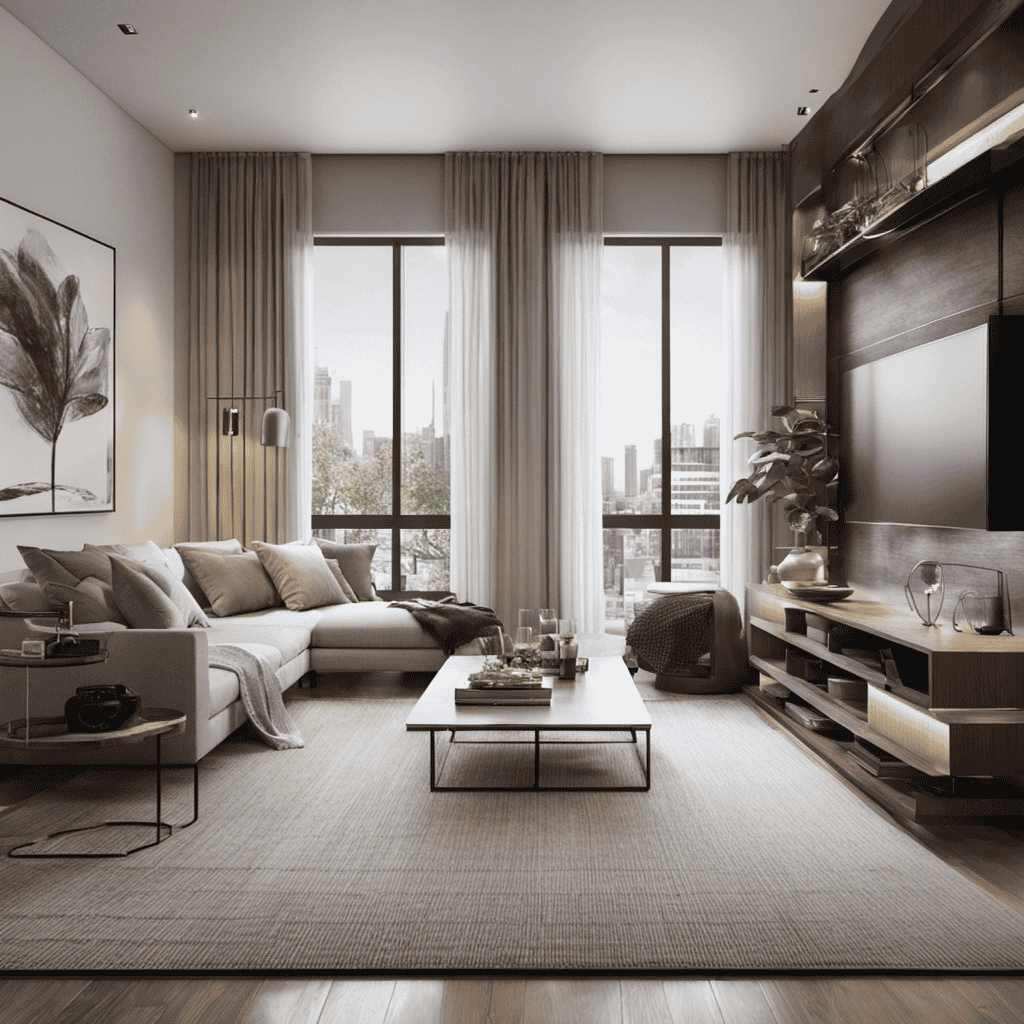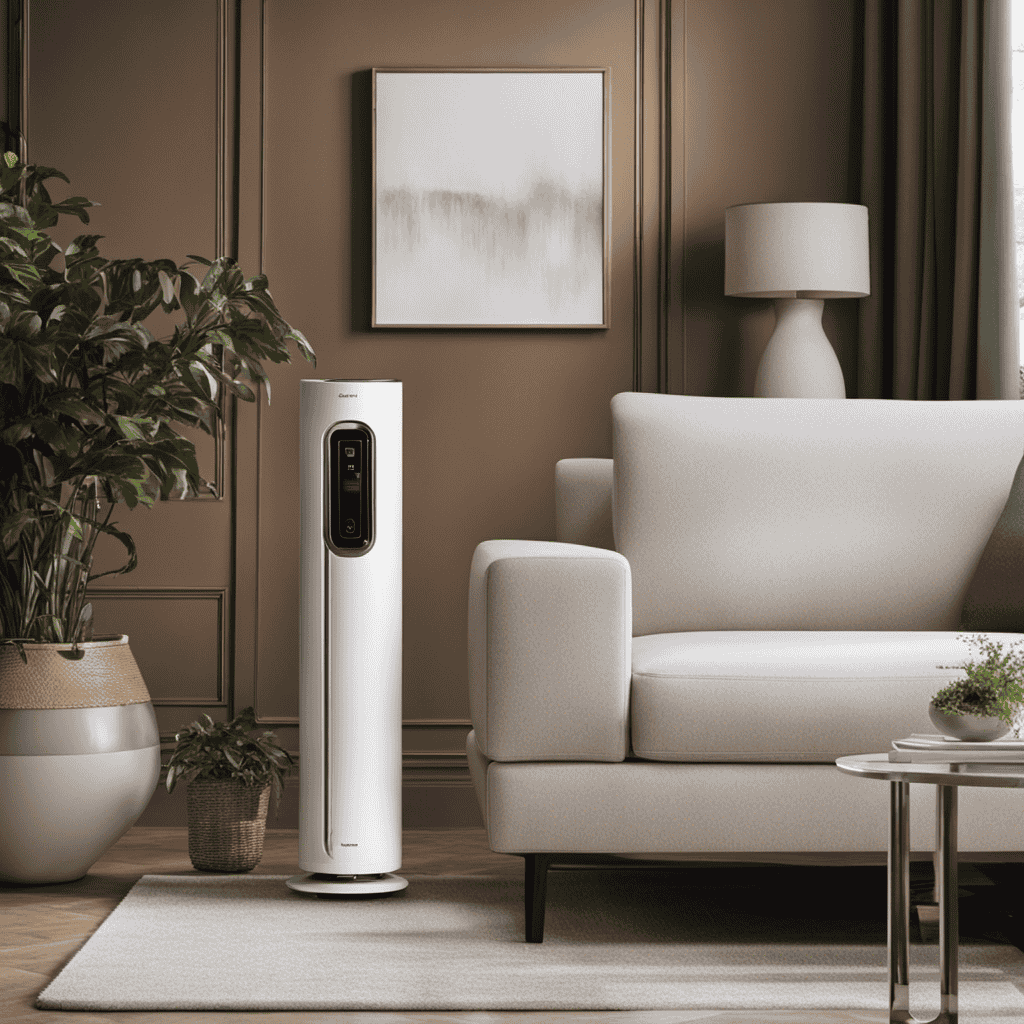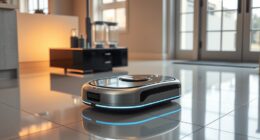Do you know the recommended frequency for changing the air filter in your air purifier? Well, all the information you need can be found right here.
In this article, I’ll be sharing some expert advice on the recommended frequency of air filter replacement, as well as the signs that indicate it’s time for a change.
Plus, I’ll provide some useful tips on how to extend the lifespan of your air filters.
So, let’s dive in and make sure your air purifier is running at its best!
Key Takeaways
- The recommended frequency of air filter replacement for air purifiers is typically every 3 to 6 months.
- Factors such as the quality of the air being filtered, frequency of use of the air purifier, size of the filter, and efficiency of the purifier can affect the lifespan of the air filter and the need for replacement.
- Signs indicating the need for air filter replacement include an increase in dust accumulation, decreased airflow, presence of strong odors, and allergy symptoms.
- Techniques to extend the lifespan of air filters include understanding the difference between cleaning and replacing, proper maintenance techniques, regular vacuuming, sealing gaps in the filter housing, and maintaining filter effectiveness.
Factors That Determine Air Filter Lifespan
There are several factors that determine how long an air filter will last in an air purifier.
The first factor is the quality of the air being filtered. If the air quality is poor, the filter will likely become clogged more quickly, reducing its lifespan.
Another factor is the frequency of use. If the air purifier is running constantly, the filter will need to be replaced more often compared to one that is used intermittently.
Additionally, the size of the filter and the efficiency of the purifier can also impact filter longevity. A larger filter may have a longer lifespan, while a more efficient purifier may help extend the filter’s life by capturing more particles.
Overall, it is important to consider these factors when determining how often to change the air filter in an air purifier.
Recommended Frequency of Air Filter Replacement
The recommended frequency to replace the air filter in an air purifier is typically every 3 to 6 months. However, several factors can affect the replacement frequency.
Factors such as the air quality in your area, the amount of pollutants present, and the usage of the air purifier can impact how quickly the filter gets clogged and loses its effectiveness.
Regular filter changes are essential for maintaining optimal air quality in your home or office. By replacing the air filter regularly, you ensure that the air purifier can continue to effectively remove dust, pollen, pet dander, and other harmful particles from the air. This not only improves the air you breathe but also helps to reduce allergies, asthma symptoms, and respiratory issues.
Regular filter changes also extend the lifespan of your air purifier by preventing the buildup of dirt and debris, which can strain the motor and reduce its efficiency.
Signs That Indicate It’s Time to Change the Air Filter
One way to tell if it’s time to replace the air filter is by checking for an increase in dust accumulation throughout your home. Dust buildup on surfaces and furniture can be an indicator that your air filter is no longer effectively capturing particles.
Here are three signs that suggest it’s time for a filter replacement:
-
Decreased airflow: If you notice a decrease in the amount of air coming out of your air purifier, it may be due to a clogged filter. Reduced airflow indicates that the filter is no longer able to efficiently pull in and clean the air.
-
Strong odors: If you start to notice persistent odors in your home that the air purifier used to eliminate, it could be a sign that the filter is saturated and unable to effectively remove odors.
-
Allergy symptoms: If you or your family members experience an increase in allergy symptoms, such as sneezing or itchy eyes, it might be a result of a dirty or worn-out filter that is no longer able to trap allergens effectively.
How to Extend the Lifespan of Air Filters
When it comes to extending the lifespan of air filters, there are a few key points to consider.
First, it’s important to understand the difference between cleaning and replacing the filter. Cleaning can be effective in some cases, but it’s crucial to use proper techniques to ensure the filter’s effectiveness is not compromised.
Additionally, implementing proper maintenance techniques, such as regular vacuuming and sealing any gaps in the filter housing, can greatly prolong the lifespan of the filter and maintain its efficiency.
Cleaning Vs. Replacing
If you want to maintain the effectiveness of your air purifier, you should know that cleaning the air filter is not always enough; sometimes, you need to replace it. Cleaning methods can help remove dust and debris, but they may not be sufficient for eliminating bacteria, allergens, and other microscopic particles.
Here are three reasons why replacing the air filter is essential for optimal air purifier performance:
-
Accumulation of contaminants: Over time, air filters become clogged with pollutants, reducing their efficiency. Cleaning may remove some debris, but it won’t eliminate all the accumulated contaminants, leading to decreased air quality.
-
Reduced airflow: As air filters get dirty, they restrict the airflow in the system. This can strain the motor and decrease the air purifier’s ability to effectively circulate clean air in the room.
-
Lifespan of the filter: Even with regular cleaning, air filters have a limited lifespan. Eventually, they become saturated with pollutants and lose their ability to effectively filter the air. Replacing the filter ensures optimal performance and maintains the air purifier’s effectiveness in improving indoor air quality.
Proper Maintenance Techniques
To ensure optimal performance of your air purifier, it’s important to regularly clean and replace the air filter. Proper maintenance techniques can help in prolonging the filter lifespan and ensuring that your air purifier continues to provide clean and healthy air.
Cleaning the air filter should be done at least once every month or as recommended by the manufacturer. Begin by unplugging the air purifier and removing the filter from its housing. Gently vacuum or brush off any visible dust or debris on the filter. If the filter is washable, rinse it under running water until it is clean and allow it to dry completely before reinserting it.
If the filter is not washable, it should be replaced with a new one according to the manufacturer’s guidelines. By following these cleaning techniques, you can maintain the efficiency and effectiveness of your air purifier.
Prolonging Filter Effectiveness
One way to ensure your filter remains effective is by regularly cleaning or replacing it as recommended. Here are three important steps you can take to prolong the life of your air filter and increase air quality:
-
Clean the filter regularly: Dust and debris can accumulate on the filter over time, reducing its efficiency. Use a vacuum cleaner or a soft brush to gently remove the dirt from the filter. This will help maintain its effectiveness and prevent clogging.
-
Monitor the air quality: Keep an eye on the air quality in your home or office. If you notice an increase in dust or allergens, it may be a sign that your filter needs to be replaced sooner than scheduled.
-
Follow manufacturer’s guidelines: Each air purifier has specific recommendations for filter maintenance. Read the user manual carefully and adhere to the suggested cleaning or replacement intervals to ensure optimal performance.
By following these steps, you can extend the life of your air filter and enjoy cleaner, healthier air.
Transitioning into the next section, let’s now explore the importance of regular air filter maintenance.
Importance of Regular Air Filter Maintenance
Regularly changing the air filter in your air purifier is crucial for maintaining its efficiency. The air filter replacement frequency depends on various factors such as the type of purifier, the usage, and the air quality in your surroundings. However, as a general guideline, it is recommended to replace the air filter every 3 to 6 months.
Regular filter changes offer several benefits. Firstly, it helps to ensure that the air purifier is continuously removing pollutants and allergens from the air. A clogged or dirty filter can hinder the purifier’s performance and reduce its effectiveness.
Secondly, clean filters help to improve the overall air quality in your home, promoting a healthier living environment.
Lastly, regular maintenance of the air filter can extend the lifespan of your air purifier, saving you money in the long run.
Different Types of Air Filters and Their Lifespan
When it comes to air purifiers, understanding the lifespan of different types of filters is crucial.
HEPA filters, for example, are known for their high efficiency and can typically last anywhere from 6 months to 1 year, depending on usage and air quality.
Carbon filters, on the other hand, require regular maintenance to ensure optimal performance, as they tend to get saturated with pollutants over time.
Lastly, washable filters may seem convenient, but their effectiveness can vary, and they may not be able to capture smaller particles as effectively as disposable filters.
Lifespan of HEPA Filters
The lifespan of HEPA filters can vary depending on usage and air quality. HEPA filters are designed to capture particles as small as 0.3 microns, making them highly efficient in removing allergens and pollutants from the air.
Here are three ways to prolong the lifespan of HEPA filters and increase air purifier efficiency:
-
Regular cleaning: Cleaning the pre-filter and replacing it when necessary reduces the load on the HEPA filter, allowing it to work more effectively and extending its lifespan.
-
Proper maintenance: Following the manufacturer’s instructions for maintenance, such as changing the filters at recommended intervals, ensures optimal performance and longevity of the HEPA filter.
-
Minimizing airborne contaminants: Taking steps to reduce the presence of dust, pet dander, and other pollutants in your environment can help reduce the strain on the HEPA filter, prolonging its lifespan and improving air purifier efficiency.
Maintenance for Carbon Filters
To ensure the longevity of your carbon filter, it’s important to follow the manufacturer’s instructions for maintenance and replace it as recommended.
Carbon filters are a popular choice for air purifiers due to their ability to effectively remove odors, chemicals, and volatile organic compounds (VOCs) from the air. Activated carbon, the key component of these filters, works by adsorbing these pollutants onto its porous surface.
Over time, however, the activated carbon becomes saturated and loses its effectiveness. Regular maintenance, such as vacuuming or gently washing the filter, can help extend its lifespan.
Additionally, some carbon filter alternatives, such as impregnated carbon or carbon pellets, offer similar benefits but may have different maintenance requirements.
Effectiveness of Washable Filters
For optimal performance, regularly cleaning your washable filter is essential. Washable filters offer several advantages over disposable filters, but it’s important to consider both the pros and cons before making a decision.
Here are three key points to consider:
-
Reusability: One of the main benefits of washable filters is that they can be reused multiple times. This not only saves money in the long run but also reduces waste.
-
Environmental Impact: Washable filters are more eco-friendly compared to disposable filters. By using a washable filter, you can significantly reduce the number of filters that end up in landfills.
-
Maintenance: While washable filters are reusable, they require regular cleaning to maintain their effectiveness. Failure to clean the filter regularly can lead to reduced efficiency and increased strain on the air purifier.
How to Choose the Right Air Filter for Your Air Purifier
When choosing the right air filter for your air purifier, you’ll want to consider factors such as the size of the particles you want to filter out and the specific needs of your space.
To begin, it’s important to understand how to clean air filters properly. For reusable air filters, the process usually involves gently washing the filter with mild soap and water, allowing it to dry completely before reinserting it into the air purifier. This method not only saves money on constantly buying new filters but also benefits the environment by reducing waste.
Additionally, reusable air filters are designed to last longer and can effectively capture a wide range of particles, including dust, pollen, pet dander, and even mold spores.
When it comes to choosing the right air filter, considering these factors will ensure the best performance and efficiency for your air purifier.
Common Mistakes to Avoid When Changing Air Filters
One common mistake to avoid is neglecting to check the manufacturer’s recommendations for how often the air filter should be changed. This is crucial because different air purifiers have varying requirements based on factors such as usage and the environment they are in. By following the manufacturer’s guidelines, you can ensure that your air purifier operates at its optimal efficiency and effectiveness.
Here are three best practices to keep in mind when changing air filters:
-
Regular Inspections: Regularly inspect the air filter for any signs of dirt, debris, or damage. This will help you determine if it needs to be replaced sooner than the recommended timeframe.
-
Timely Replacements: Replace the air filter according to the manufacturer’s recommendations. Waiting too long can result in decreased performance and potential damage to the air purifier.
-
Quality Filters: Invest in high-quality air filters that are compatible with your specific air purifier model. Using inferior or incorrect filters may compromise the filtration efficiency and reduce the lifespan of the purifier.
Frequently Asked Questions
Can I Clean and Reuse My Air Filter Instead of Replacing It?
Yes, you can clean and reuse your air filter in an air purifier, but it’s not recommended. Regularly replacing the air filter is beneficial as it ensures optimal filtration and improves the overall air quality in your space.
Is It Necessary to Change the Air Filter if I Don’t Use My Air Purifier Frequently?
If my air purifier has a built-in indicator, should I still change the air filter? Although I don’t use it frequently, a dirty filter can impact the air quality in my home.
What Happens if I Don’t Replace the Air Filter at the Recommended Frequency?
If I don’t replace the air filter in my air purifier at the recommended frequency, the filter will become clogged with dirt and debris. This can reduce the purifier’s efficiency and may even lead to poor air quality.
Can Using a Lower-Quality Air Filter Affect the Performance of My Air Purifier?
Using a low-quality air filter can greatly impact the performance of your air purifier. It may not effectively remove pollutants, reducing indoor air quality. Invest in a high-quality filter for optimal performance.
Are There Any Specific Factors That Can Cause the Air Filter to Deteriorate Faster Than Usual?
Factors affecting air filter lifespan include high levels of pollutants, frequent use, and poor maintenance. Signs of a deteriorating air filter include reduced airflow, increased dust buildup, and decreased air purification efficiency. Regular replacement is crucial for optimal performance.
Is There a Standard Time Frame for Changing Air Filters in Air Purifiers?
The air purifier filter change frequency depends on various factors such as the air quality in your area, the size of your home, and the type of air purifier you have. However, it is generally recommended to change the air purifier filter every 3 to 6 months for optimal performance.
Conclusion
In conclusion, changing the air filter in your air purifier is absolutely crucial for maintaining clean and healthy indoor air. Neglecting this task can lead to a buildup of pollutants and allergens, creating a breeding ground for bacteria and unpleasant odors.
By replacing your air filter regularly, you ensure that your air purifier functions at its best, providing you with the freshest and purest air possible.
So don’t delay, take action now and experience the transformative power of a well-maintained air filter in your home.










